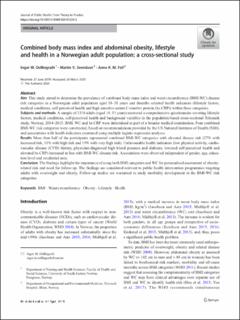| dc.contributor.author | Oellingrath, Inger Margaret | |
| dc.contributor.author | Svendsen, Martin Veel | |
| dc.contributor.author | Fell, Anne Kristin Møller | |
| dc.date.accessioned | 2021-03-25T11:35:45Z | |
| dc.date.available | 2021-03-25T11:35:45Z | |
| dc.date.created | 2020-08-07T11:24:06Z | |
| dc.date.issued | 2020 | |
| dc.identifier.citation | Oellingrath, I. M., Svendsen, M. V., & Fell, A. K. (2020). Combined body mass index and abdominal obesity, lifestyle and health in a Norwegian adult population: A cross-sectional study. Journal of Public Health. | en_US |
| dc.identifier.issn | 2198-1833 | |
| dc.identifier.uri | https://hdl.handle.net/11250/2735515 | |
| dc.description.abstract | Aim: This study aimed to determine the prevalence of combined body mass index and waist circumference (BMI-WC) disease risk categories in a Norwegian adult population aged 18–51 years and describe selected health indicators (lifestyle factors, medical conditions, self-perceived health and high sensitive serum C-reactive protein (hs-CRP)) within these categories. Subjects and methods: A sample of 1318 adults (aged 18–51 years) answered a comprehensive questionnaire covering lifestyle factors, medical conditions, self-perceived health and background variables in the population-based cross-sectional Telemark study, Norway, 2014–2015. BMI, WC and hs-CRP were determined as part of a broader medical examination. Four combined BMI-WC risk categories were constructed, based on recommendations provided by the US National Institutes of Health (NIH), and associations with health indicators examined using multiple logistic regression analyses. Results: More than half of the participants represented combined BMI-WC categories with elevated disease risk (27% with increased risk, 11% with high risk and 19% with very high risk). Unfavourable health indicators (low physical activity, cardiovascular disease (CVD) history, physician-diagnosed high blood pressure and diabetes, lowered self-perceived health and elevated hs-CRP) increased in line with BMI-WC disease risk. Associations were observed independent of gender, age, education level and residential area. Conclusion: The findings highlight the importance of using both BMI categories and WC for personalised assessment of obesity-related risk and need for follow-up. The findings are considered relevant to public health intervention programmes targeting adults with overweight and obesity. Follow-up studies are warranted to study morbidity development in the BMI-WC risk categories. | en_US |
| dc.language.iso | eng | en_US |
| dc.rights | Navngivelse 4.0 Internasjonal | * |
| dc.rights.uri | http://creativecommons.org/licenses/by/4.0/deed.no | * |
| dc.title | Combined body mass index and abdominal obesity, lifestyle and health in a Norwegian adult population: a cross-sectional study | en_US |
| dc.type | Peer reviewed | en_US |
| dc.type | Journal article | en_US |
| dc.description.version | publishedVersion | en_US |
| dc.rights.holder | © The Author(s). | en_US |
| dc.source.journal | Journal of Public Health | en_US |
| dc.identifier.doi | https://doi.org/10.1007/s10389-020-01259-2 | |
| dc.identifier.cristin | 1822164 | |
| cristin.ispublished | true | |
| cristin.fulltext | original | |
| cristin.qualitycode | 1 | |

